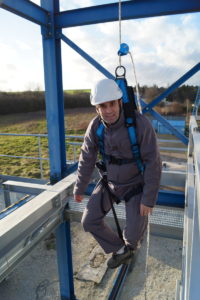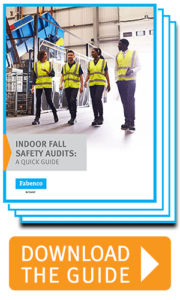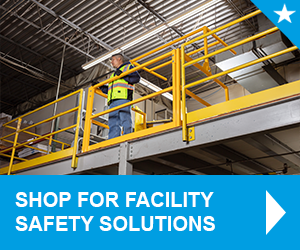
We know that falls are among the most common causes of injuries in the workplace and it’s really no surprise—things like elevated work surfaces, walkways, rooftops, holes in floors and walls, ladders, scaffolding, and slippery surfaces are common, especially in industries like manufacturing and construction. Even with the best fall protection, safety managers need to have a plan in place for if and when a fall occurs. Today we are going to review the steps you need to take after a slip, trip, or fall does happen on your worksite.
Immediate Response to a Fall
This is dependent on the type of fall and where the worker finds themselves. No matter what, you must check to make sure the individual is okay. If they have sustained an injury, large or small, you must seek some sort of medical attention. Ascertain the level of injury: should the individual be moved, can they move on their own, or should they remain still until emergency personnel arrive? You should always have at least one person on your work team with current and active first aid training to help evaluate the situation.
If the individuals are in fall arrest harnesses, this requires special attention as they’ll remain suspended until someone brings them down. There are two ways to rescue workers in this position: self-rescue and aided rescue. Of course, your emergency response team should be notified no matter which technique is employed.
A Note About Suspension Trauma
Before we continue, it’s worth noting: after a worker falls and is caught by a safety harness, the danger is not over. Even though safety lanyards and harnesses can save lives, your employees won’t be comfortable while they are suspended. If they can’t relieve the pressure the harness places on their legs, blood flow can be restricted causing a situation known as suspension trauma, the results of which can be mild discomfort to lost consciousness. The first thing a fallen employee should do is relieve harness pressure with a foot wrap or trauma straps.
Self Rescue Techniques
In order to self-rescue, employees need to be trained on the process as well as be able-bodied enough to perform it. Self-rescue techniques include:
- Rappelling
- Using the foot wrap to lower down (note: this should only be done for distances shorter than 35 feet).
Aided Rescue Techniques
Sometimes fallen workers supported by fall arrest harnesses and safety lanyards won’t be able to get themselves out of the situation. A worker that has a heart attack or other illness that causes the fall is in shock, or is injured as a result of the fall despite the harness will not be able to rescue themselves.
In the event that a worker is unable to perform a self-rescue, intervention by an on-site emergency response team is needed. If you are in a 911 service area, you can dial this number to request medical attention and other emergency services but, according to Fall Protection: Responding to Emergencies, many 911 responders are not trained to rescue a suspended worker. Aided rescues require both trained rescuers and appropriate rescue equipment—your team should have both a working plan and the right equipment for a rescue in place should you need it.
A few things to keep in mind when it comes to rescue equipment:
- Will it be ready when you need it?
- Does your rescue team know how to use them?
- Can you use forklift, extension ladder, or elevated platforms, or do you need technical rescue equipment?
According to the aforementioned Fall Protection: Responding to Emergencies, on-site equipment such as extension ladders, forklifts, or elevating platforms for aided rescue can be used whenever possible. If this equipment isn’t available, you should have technical rescue equipment as part of your rescue plan. This includes brake-tube systems, pulley systems, and winch systems.
1. Brake-tube systems: A brake tube uses rope friction — the rope wraps around the brake tube — to lower a suspended worker.
2. Pulley systems: A pulley is a simple machine that’s been used for centuries to move loads. They are safe and can raise or lower a suspended worker from any height — so long as you have enough rope.
3. Winch systems: These use a small system of gears that are easy to operate and can raise or lower a suspended worker with little physical effort.
To learn more about technical rescue equipment, we recommend reading the full document.
Post-Rescue Response
Once the rescue has been successfully completed and the fallen individual is safe, it’s time to evaluate what happened. Not only is this necessary to complete the required reports to OSHA, but it will also serve as a learning tool to help workers avoid similar situations in the future. It’s also important to review your facility’s safety procedures, fall protection devices, and employee safety training to see where improvements could be made. This might mean installing other safety equipment like a guardrail, a ladder guard, and/or a swinging safety gate.
File Your Accident Reports
OSHA requires companies to report workplace injuries within 24 hours of the accident if the injuries sustained require more than basic first-aid. This pertains to the following situations:
- Work-related injuries that result in a loss of consciousness, days off work, restricted work, or if the worker has to be transferred to another job.
- Work-related injuries that require medical treatment beyond first aid.
- Any work-related injury resulting in fractured or cracked bones or teeth, or punctured eardrums.
The purpose of collecting this information is to help employers, employees, and OSHA evaluate the safety of the workplace. It also helps identify and define industry hazards so OSHA can work to prevent them from happening again.
Keep Your Records In Order
Employers must maintain copies of injury records at the worksite for a minimum of five years. They’re also required to post a summary of the previous year’s injury reports each February through April in a place that employees, supervisors, and other shareholders can easily access them. In addition, employers are required to provide copies of the records to current and former employees (or their representatives) when requested.
Plan for Post-Accident Inspections
If there is a serious injury at a workplace, OSHA inspectors will complete an inspection of the facility or job site. This happens at the convenience of the OSHA inspector and will be an unannounced visit. Employers should expect this visit at any time and have the right documents and reports at the ready.
![Dowload the Indoor Fall Safety Audit Guide]() Conduct A Facility Fall Safety Review
Conduct A Facility Fall Safety Review
Review your facility’s fall hazards and evaluate the impact they may have on workers and adjust your policies, procedures, and equipment accordingly.
This might mean you need a combination of active fall arrest systems, like fall arrest harnesses and safety lanyards, and passive systems like guardrails and a swinging safety gate. Additional protection like toeboards, hatch covers, and safety nets may also be required. Adding visual reminders like signs, posters, and warning lines can also help keep safety top of mind.
Your review should also include an inspection of the fall protection you already have in place. Make sure guardrails haven’t corroded or been otherwise compromised. Check your harnesses and lanyards for wear and tear (this should be done prior to every use). Thoroughly inspect your swinging safety gate, ladders, and hatch guards for anything that might indicate a safety hazard.
Conclusion
OSHA has mandated very specific rules regarding the way in which workplaces are set up, the safety equipment that’s required, and how employers handle a fall if one occurs. Understanding these rules and complying with them is essential for creating a healthy, safe, and productive work environment.







